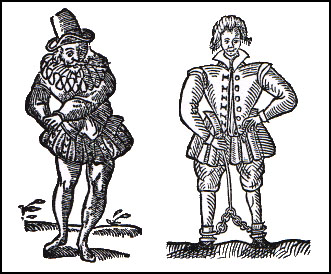- To The Reader
- 1. Shakspere or Shakespeare?
- 2. Shakespeare a Pseudonym?
- 3. Treasure Texts
- 3.1. Harvey - Nashe The Players
- 3.1.1. Harvey Gratulationes Valdinenses
- 3.1.2. Harvey, Three proper
- 3.1.3. Lyly, Pappe with an hatchet
- 3.1.4. Harvey, Foure Letters
- 3.1.5. Nashe, Strange Newes
- 3.1.6. Harvey, Piercesís Supererogation
- 3.1.7. Harvey, A New Letter
- 3.1.7.1 Ox, Old Ass, Gentlewoman
- 3.1.8. Peele, The Old Wives Tale
- 3.1.9. Shakespeare, Loves Labors Lost
- 3.1.10. Nashe, Have with you
- 3.2. Gascoigne-Willobie
- 3.3. Munday - Shakespeare
- 3.4. Spenser - Edwards
- 3.5. Lyly-Greene-Chettle
- 3.6. Hall-Marston-Parnassus
- 3.7. Sir Thomas Smythes voiage
- 3.8. List of contemporary witnesses
- 3.1. Harvey - Nashe The Players
- 4. Edward de Vere
- 5. Works
- 6. Ben Jonsonís Forgery
- 7. Research for Shake-speare
- 9. Relationship
- 10. Chronology
3.1. The Harvey-Nashe Quarrel
ARGUMENT

Gabriel Harvey, Thomas Nashe
The two literary rivals Thomas Nashe (1567-1601) and Gabriel Harvey (1550-1630) referred to the Earl of Oxford as being the creator of the character Sir John Falstaff. In the heat of their passions they both reveal the identity of the man behind the name “William Shakespeare”, and we can observe the presence of Shakespeare during their conflict.
It is important to understand the underlying logic that forms texts 3.1.1. to 3.1.10. to an integral unit. The texts are presented and commented accurately, albeit in an abridged version. With the exception of the comedy Loves labors lost (First editon, 1598) modern spelling is used throughout. The use of capital or italic letters is taken directly from the original.
CONTENTS
3.1. The Harvey-Nashe-Quarrel
3.1.1. Harvey, Gratulationes Valdinenses, 1578
3.1.2. Harvey, Three proper and wittie familiar Letters, 1580
3.1.3. Lyly, Pappe with an hatchet, 1589
3.1.4. Harvey, Foure Letters and certaine Sonnets, 1592
3.1.5. Nashe, Strange Newes, 1593
3.1.6. Harvey, Pierces Supererogation, 1593
3.1.7. Harvey, A New Letter, 1593
3.1.7.1. Ox, Old Ass, Gentlewoman
3.1.8. Peele, The Old Wives Tale, 1595
3.1.9. Shakespeare, Loves Labors lost, ed. 1598
3.1.10. Nashe, Have with You to Saffron Walden, 1596
The Players
- Elizabeth Tudor, Queen of England.
- Hercule-François Duke of Alençon („Monsieur“), Elizabeth’s french suitor from 1578-1583, the youngest brother of the French king Henri III.
- Don Juan d’Austria, half-brother of king Philipp of Spain, the victor of Lepanto, Spanish Governor to the Netherlands, Elizabeth’s prominent enemy.
- William Cecil, Lord Burghley, Lord High Treasurerer, promoter of the „French marriage“.
- Edward de Vere, EARL OF OXFORD, promoter of the „French marriage“.
(The French Marriage was the proposed marriage of Queen Elizabeth to the brother of the French King, Hercule-François Duke of Alençon. A catholic prince consort could have caused huge problems after England's break with the pope, however an alliance with such a powerful nation as France could have bought many advantages. The argument ended with the unexpected death of the Duke in 1583.)- Robert Dudley, Earl of Leicester, adversary to the „French marriage“.
- Sir Christopher Hatton, Knight, adversary to the „French marriage“.
- Lord Philip Sidney, adversary to the „French marriage“.
- GABRIEL HARVEY, academical rhetor, follower of the Earl of Leicester.
- Richard Harvey, theologian and astrologer, younger brother of Gabriel Harvey.
- John Harvey, physician, younger brother of Gabriel Harvey.
- Martin Marprelate (pseud.), probably John Penry, puritan adversary to the influence of the bishops of the Anglican Church.- John Lyly (alias Pap Hatchet), dramatist and poet, secretary of the Earl of Oxford, anti-Marprelate-propagandist.
- Robert Greene, author and poet, friend of the Earl of Oxford, anti-Marprelate-propagandist.
- THOMAS NASHE, satirist, friend of Robert Greene and the Earl of Oxford, anti-Marprelate-propagandist, an ardent adversary of Gabriel Harvey.
